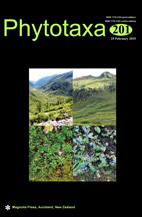Abstract
The genus Gracilaria is the major source of agarose in the world today and is one of the most species-rich genera in the Rhodophyta. Flat Gracilaria species are among the most taxonomically challenging taxa due to their widespread phenotypic plasticity among all species. Gracilaria cearensis is a flat species described in 1965 from Brazil. Its original description is not conducive to accurate taxonomic identifications and the delineation of this taxon remains elusive. New samples of G. cearensis were collected across a coastal length of 500 km including its type locality. Universal Plastid Amplicon (UPA) and the rbcL gene were used to confirm the phylogenetic and taxonomic status of this poorly known species. Results showed that this is a distinct species despite morphological similarities to G. hayi, G. cuneata, G. curtissiae, G. brasiliensis and G. galetensis. G. cearensis is sister to G. hayi yet the genetic divergence between these two species was 2% for rbcL and 1.08% for UPA, enough to consider them distinct taxa. However, newly generated molecular data placed G. smithsoniensis, another morphologically similar species, as conspecific with G. cearensis with only 0.07% rbcL sequence divergence between them.

